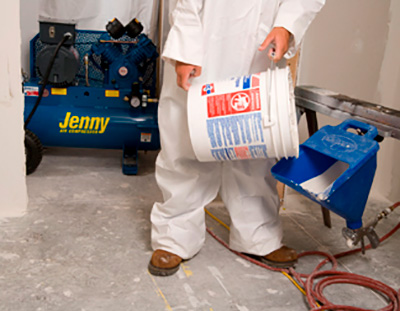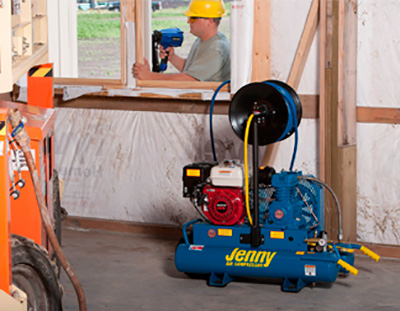Compressors come in a variety of configurations and designs, from stationary and portable to rotary and piston. For the purposes of this technology discussion, the focus will be on portable reciprocating piston compressors, like those used to power nail guns and other air tools utilized on residential and commercial construction sites. But before exploring the areas where technology in these machines has progressed, it’s worth mentioning the tried and true fundamentals of compressor functionality that have mostly remained unchanged.
A piston compressor is similar to the internal combustion engine in the way it operates, with each involving the up and down movement of a piston in a cylinder. The primary difference, of course, is that the engine’s piston is combusting a mixture of fuel and air, while the piston in an air compressor pump is compressing air alone.
Both engines and compressors have seen adjustments in performance and design over the years, but the basic operating principles for each remain the same. The changes have been gradual and efficiency has improved, but not by any great order of magnitude. And in other areas, there have been no changes at all.

For example, car engine and compressor cylinders, to this day, are still made of cast iron. Manufacturers could consider tapping into the best materials modern science has to offer, but the added cost of construction — and corresponding hike in the price tag — would far outweigh any minimal benefit to the end user.
Manufacturers have been wise to avoid expensive upgrades that simply don’t translate into real customer benefits. At the end of the day, cylinder capacity and whether a compressor is a single stage or two stage unit will still have a much greater influence on output volumes and pressures than would any changes to a compressor’s basic design.
Upgrades For Uptime
Rather than reinventing the wheel on a relatively simple machine, manufacturers have instead focused their time and attention on practical innovations that combine to make a true difference, most notably with regard to an air compressor’s reliability.
For many contractors, an air compressor is the driving force of almost all the work they do at a jobsite. Therefore, equipment reliability is obviously among their greatest concerns. Compressor pumps have seen some helpful upgrades in recent years that help contribute to longevity and better overall performance.

Naturally, modern machining processes controlled by computers have played a crucial role in compressor technology and the reliability of individual units. A pump’s cylinder wall can now be machined and honed to an exactness. This reduces bore tolerances to levels that were almost unachievable 50 years ago. Now that this degree of engineering is commonplace, the potential for compressor failure based on a machining error is virtually nonexistent.
Other enhancements have come in the form of added features or improvements to existing components. Thanks to breakthroughs in metallurgy, piston ring sets are now made of wear-resistant materials that do a better job of preventing air and oil leakage in the cylinder. Specially designed rod inserts on the connecting rod-crankshaft interface help prevent damage to the pump’s main components. Additionally, the introduction of rugged, oversize crankshaft bearings has provided a similar benefit of added durability to the pump’s design.
Another factor in equipment uptime, particularly for piston compressors, engines or other machines whose function involves fast mechanical movements that can create heat, is its ability to prevent overheating. Some air compressors are constructed to promote additional airflow to assist with cooling the pump. This has been done by incorporating a directional air shroud or adding an airfoil blade design on a compressor’s flywheel.
The development of synthetic lubricants has also aided pump efficiency, while special compressor-pump oil helps ensure that a compressor’s piston, crankshaft, bearings, rings and cylinder are always protected, further contributing to equipment reliability. Again, while only offering an incremental change by itself, improved lubrication is one of many technological advances that contribute to a better overall end result.
Simplified Maintenance
While a reliable and high-performing compressor is bound to experience reduced downtime, every piece of equipment still requires periodic maintenance. Air compressors are equipped with a number of standard features to keep things running smoothly until routine service needs are addressed. These include enclosed belt guards and protective mounted fittings to defend against equipment damage, special unloading valves to assist in engine or motor starting, pressure relief valves to keep the compressor functioning properly, and pressure gauges to assist operators in monitoring performance.
Recently manufacturers have begun to offer additional features to further improve serviceability. Oil sight glass allows an operator to check the oil level of the compressor pump in mere seconds. Furthermore, it serves as a handy reminder to a busy contractor on a hectic jobsite that the oil needs to be checked in the first place. Another update to some pumps is the introduction of easy-access unloader pins that can be lubricated or replaced in under 10 minutes. It wasn’t uncommon for the replacement of traditional pins to take well over an hour.
Compressor companies will undoubtedly continue to look for new technology and other ways to simplify maintenance tasks for their customers, but will aim to do so without turning air compressors into a convoluted mess of needless features. Manufacturers understand that their equipment performs one primary function — compressing air — and are smart enough to build their machines using a common sense design that keeps everything relatively simple.
Getting Around
Another thing manufacturers figured out early on was the need for compressors to be portable. A number of wheeled portable and hand carry air compressors are on the market and appropriately equipped with pneumatic tires and handles to enhance jobsite maneuverability. Chalk up portability as another area where companies have done just enough with respect to the ergonomic aspect of moving equipment without going overboard.
Technology + Support = Success
While the advancements put forth in compressor technology have been made to assist end users in various ways, many compressor users haven’t concerned themselves with these upgrades and new features. Instead they’ve simply focused on getting equipment that works, or in some cases on getting equipment at the lowest price.
Often this strategy paid off. But today the portable air compressor market is shrinking, with several manufacturers exiting the business in the last few years and leaving customers to fend for themselves in the process. If a need for parts or product support arises, users may not have anywhere to turn for help. Now, more than ever, customers need to closely examine their equipment choices to ensure they are choosing brands that have exhibited a commitment to sticking around for the long haul — perhaps through the introduction of technological improvements and value-added features.
A compressor is more than an air pump. It’s an essential tool that allows thousands of contractors to make a living. Keep an eye out for the latest and greatest that air compressor technology has to offer, no matter how small the advancement, and chances are you’ll be rewarded with profitable returns for years to come.
For more information about air compressors and Jenny Products, go here.



